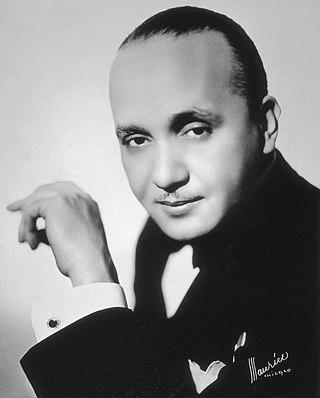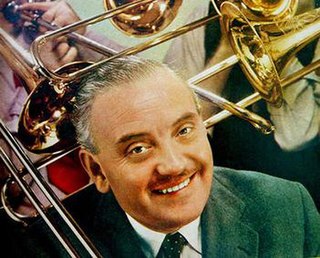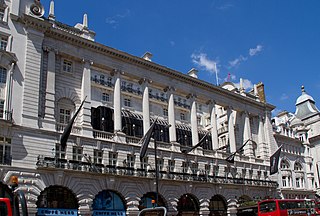Related Research Articles
William Joseph Mayerl was an English pianist and composer who built a career in music hall and musical theatre and became an acknowledged master of light music. Best known for his syncopated novelty piano solos, he wrote over 300 piano pieces, many of which were named after flowers and trees, including his best-known composition, Marigold (1927). He also ran the successful School of Syncopation for whose members he published hundreds of his own arrangements of popular songs.
Swing music is a style of jazz that developed in the United States during the late 1920s and early 1930s. It became nationally popular from the mid-1930s. Swing bands usually featured soloists who would improvise on the melody over the arrangement. The danceable swing style of big bands and bandleaders such as Benny Goodman was the dominant form of American popular music from 1935 to 1946, known as the swing era, when people were dancing the Lindy Hop. The verb "to swing" is also used as a term of praise for playing that has a strong groove or drive. Musicians of the swing era include Duke Ellington, Benny Goodman, Count Basie, Cab Calloway, Benny Carter, Jimmy Dorsey, Tommy Dorsey, Woody Herman, Earl Hines, Bunny Berigan, Harry James, Lionel Hampton, Glenn Miller, Artie Shaw, Jimmie Lunceford, and Django Reinhardt.

James Fletcher Hamilton Henderson was an American pianist, bandleader, arranger and composer, important in the development of big band jazz and swing music. He was one of the most prolific black musical arrangers and, along with Duke Ellington, is considered one of the most influential arrangers and bandleaders in jazz history. Henderson's influence was vast. He helped bridge the gap between the Dixieland and the swing eras. He was often known as "Smack" Henderson.

Albert Allick Bowlly was a South African-British vocalist, crooner and dance band guitarist who was Britain's most popular singer for most of the 1930s. He recorded upwards of 1,000 songs that were listened to by millions.

Frederic Efrem Rich was a Polish-born American bandleader and composer who was active from the 1920s to the 1950s. Among the musicians in his band were the Dorsey Brothers, Joe Venuti, Bunny Berigan, and Benny Goodman. In the early 1930s, Elmer Feldkamp was one of his vocalists.

George Edward Heath was a British musician and big band leader.

Shep Fields was an American bandleader who led the Shep Fields and His Rippling Rhythm orchestra during the 1930s. His distinctive Rippling Rhythm sound was featured on big band remote broadcasts from historic hotels nationwide and remained popular with audiences from the 1930s into the early 1960s.

Louis Stone known professionally as Lew Stone was a British bandleader and arranger of the British dance band era, and was well known in Britain during the 1930s. He was known as a skillful, innovative and imaginative musical arranger.

Carroll Richard Gibbons was an American-born pianist, bandleader and popular composer who made his career primarily in England during the British dance band era.

Theodore Dudley "Red" Saunders was an American jazz drummer and bandleader. He also played vibraphone and timpani.
Federico "Fred" Díaz Elizalde was a Spanish Filipino classical and jazz pianist, composer, conductor, and bandleader, influential in the British dance band era.
Anne Lenner was an English vocalist, who sang with the British dance bands of the 1930s and 1940s. She is most closely associated with Carroll Gibbons and the Savoy Orpheans, a band who regularly played at the Savoy Hotel in London, with whom she made many studio recordings. The British bands played a softer version of the swing jazz popular in the USA during the 1930s and 1940s.

The Savoy Orpheans is a British dance band currently led by Alex Mendham. They were resident at the Savoy Hotel, London.

The Dilly London, known for over a hundred years as The Piccadilly Hotel, is a historic 5-star luxury hotel located at 21 Piccadilly in London, England.

Maurice Winnick was an English musician and dance band leader of the British dance band era.

Sydney John Lipton was a British dance band leader, popular from the 1930s to the 1960s when he led "one of the most polished of the British Dance Bands."
Debroy Somers was a British dance band leader.

Alex Mendham is an English singer, saxophonist, and bandleader. He is best known as the founder and leader of Alex Mendham & His Orchestra.
Helen Clare was a British singer who was well known in the 1930s and 1940s through her work in variety, radio, television and recording. Clare worked extensively in light entertainment, appearing on BBC Radio and recording with British dance bands. Her distinctive soprano voice saw her working with some of the biggest names of the era, including bandleaders Jack Jackson and Henry Hall. She was one of the last surviving British singers who had been active in the 1930s.
Ivor Moreton and Dave Kaye were an English musical variety double act who were known for performing syncopated piano duets together from the 1930s to the 1950s. The duo consisted of pianists Ivor Arthur Moreton and David "Dave" Kaye, who had both been members of Harry Roy's dance band, the act developing from Roy's small group, the Tiger Ragamuffins. They played at two pianos, usually with Kaye carrying the melody, and Moreton embellishing it.
References
- 1 2 Schleman, Hilton R. (1978). Rhythm on record (Repr. d. Ausg. London 1936 ed.). Westport, Conn: Greenwood Press. ISBN 978-0-313-20257-5.
- ↑ General Register Office; United Kingdom; Volume: 9; Page: 1520
- 1 2 Principal Probate Registry; London, England; Calendar of the Grants of Probate and Letters of Administration made in the Probate Registries of the High Court of Justice in England
- 1 2 General Register Office. England and Wales Civil Registration Indexes. London, England: General Register Office.
- 1 2 3 4 Digital Collections, The New York Public Library. "(still image) Sydney Kyte, (1850 - 1959)". The New York Public Library, Astor, Lenox, and Tilden Foundations . Retrieved 29 November 2024.
- 1 2 "Sydney Kyte Songs, Albums, Reviews, Bio & More..." AllMusic . Retrieved 28 November 2024.
- 1 2 3 Rust, Brian; Forbes, Sandy (1987). British dance bands on record 1911 to 1945. Harrow: General Gramophone Publications. ISBN 978-0-902470-15-6.
- ↑ McKay, George (23 November 2005). Circular Breathing: The Cultural Politics of Jazz in Britain. Duke University Press. ISBN 978-0-8223-8728-2.
- ↑ "Salle Erard". The Daily Telegraph . 17 December 1909. p. 7. Retrieved 2 December 2024.
- ↑ "Sydney Kyte Dance Orchestra's Visit". The Gloucestershire Echo . 17 August 1946. p. 4. Retrieved 1 December 2024.
- ↑ Rust, Brian (1980). 1931-1932 (Media notes). Sydney Kyte and his Piccadilly Hotel Orchestra. World Records. SH387.
- ↑ "Sydney Kyte and His Band at St George's Hall". The Hinckley Times . 10 February 1939. p. 4. Retrieved 29 November 2024.
- ↑ Broom, John (30 August 2018). A History of Cigarette and Trade Cards: The Magic Inside the Packet. Grub Street Publishers. ISBN 978-1-5267-2175-4.
- ↑ Wright, Adrian (2020). Cheer Up!: British Musical Films, 1929-1945. Boydell & Brewer. ISBN 978-1-78327-499-4.
- ↑ General Register Office; United Kingdom; Volume: 1a; Page: 845
- ↑ London Metropolitan Archives; London, England; Electoral Registers
- ↑ Sounds Vintage (Volume 3, Issue 6). 1981.